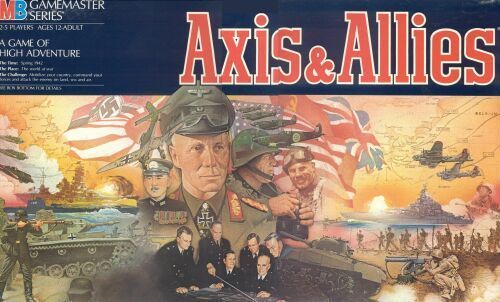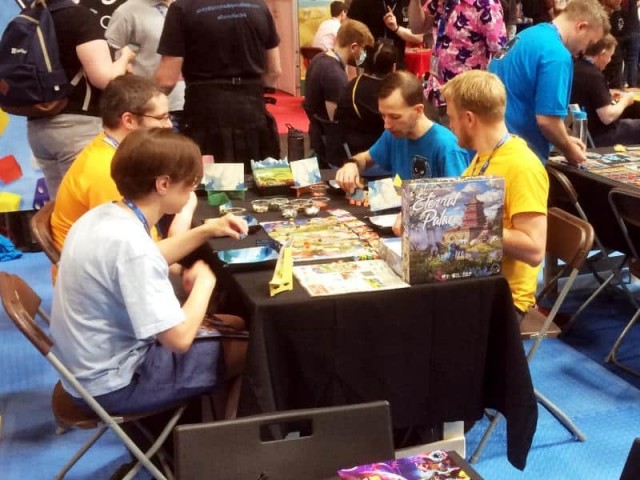You might call them “Risk-style” or “take over the world” games. You may even call them “garbage”. But myself and a lot of other folks writing and thinking about board games have taken to referring to those in which you control and conquer spatially arranged territories on a map with on-board pawns and engage in conflict resolution to determine placement or removal of pieces with other players as “Dudes on a Map” or DoaM games. I’ve been thinking a lot about the genre lately since it is one of what is really a very small number of distinguishable macro-genres among board game classifications, and also because there have been so many damn good, damn innovative games in this genre over the past ten years.
I’ve been considering why that is lately, particularly in light of recent titles like Clash of Cultures, City of Remnants, and Kemet. Not to mention some of the top games of the past decade- Nexus Ops, Chaos in the Old World, Mare Nostrum, Small World, War of the Ring and Cyclades. There are also tremendously influential DoaMs to consider like Twilight Imperium and Game of Thrones as well as maverick designs like last year’s War of 1812, burly cross-genre examples like Runewars, and the woefully underappreciated and uniquely daring Starcraft board game that managed to sneak deckbuilding into a DoaM design before Dominion changed the hobby. It strikes me that in just the past ten years, this has been one of the most mobile, innovative genres in hobby gaming.
But to get a sense of history, we’ve got to get back to where it all started. Stripping the DoaM down to its fundamental core isn’t hard, it’s one word and that word is Risk. Although Diplomacy predates it by three years and its influence on the DoaM genre is definitely concurrent with Albert Lamorrisse’s classic design, I believe that Risk is ground zero for the genre. No game more succinctly and directly speaks to the elements that comprise it. It is the ur-DoaM, and its massive influence on the direction of board games cannot be overstated, despite many modern gamers’ refusal to acknowledge the value of the design- or the fact that it can still actually be a really fun game.
Risk (and Diplomacy) set the standard. Map of the world, pieces abstractly representing units of military presence or force, production of said pieces, and an impetus to claim territory either neutral or contested in order to increase resources and the ability to field larger armies and exert more control over the map. These fundamentals are largely the same today in even the most divergent examples of the genre, with a multitude of variations and mutations employed to either reduce or increase detail. Player interaction- both on board and above aboard- tends to be high as the core actions described are those of conflict and contest.
So the lineage between today’s DoaM games and Risk is clear through these persistent principles, but between Risk’s first publication in 1957 and the next big step in DoaM evolution a lot changed in game design concepts. Detailed, conflict simulation-oriented war games emerged along with a more hobby-minded focus on strategy gaming. Dungeons and Dragons exploded. Avalon Hill issued seminal titles with DoaM ancestry such as Titan, Civilization, History of the World, and Dune. The birth of hobby gaming was very much nursed both directly and indirectly on principles carried forward from Risk and ol’ grandfather Diplomacy.

Yet Axis and Allies is really the next big step, and it was a very mainstream title even while making more wargame-oriented concepts accessible. This game also increased the potential of the genre to reach a level of detail that Risk could not accomplish with all the silhouettes of cannon crews in the world. Axis and Allies developed the ideas of Risk but brought in a new degree of specificity, which was really crucial to its success following the emergence of games as a hobbyist concern rather than as a family pastime. What followed from Lawrence Holland’s really quite groundbreaking design work were other similar games, mostly published to lasting success in Milton Bradley’s Gamemaster series. Shogun, Conquest of the Empire, and Fortress America are titles that any gamer that grew up in the 1980s knows well, and all three games have been reprinted and updated. Axis and Allies has never fallen out of print, and many variations and updates have kept it alive. Past its sell-by date, in my opinion, but it’s still a game of monumental importance.
Moving along the timeline through the 1980s, there are lesser lights like the TSR Buck Rogers game that regardless of its redundancy had some innovative concepts in terms of a fluid, mobile geography. Anything from Warrior Knights to Supremacy to Kings and Things to Wizard’s Quest incorporated some development or modification of the Risk/Axis and Allies paradigm with new thematic concepts or mechanical subsystems. Risk itself played around with change notably in 1986’s Castle Risk.
Moving into the 1990s, the German games invasion started to happen and titles like El Grande shifted the DoaM concept to an “area control” or “area majority” footing. A general retreat from longer games with unfocused goals like “take over every territory on the map” started to happen, and ideas like gauging success by victory points and timing methods to control play length started to creep into the DoaM concept. In 1997, Fantasy Flight Games published its first edition of Twilight Imperium, which was very much an Axis and Allies game on a modular space board at that point.
Despite the many positive changes that the very early Eurogames invasion affected by way of changing hobbyists’ expectations in terms of complexity, game length, and accessibility, the classical DoaM persisted. Glenn Drover’s Eagle Games wound up being more or less the sole torchbearer for the old “Gamemaster style” games and in the early 2000s they published gigantic titles like Napoleon in Europe, War! Age of Imperialism, and The American Civil War. These games relished in the excesses of the DoaM genre, with tons of “dudes”, giant maps, and burgeoning playtimes. Some folks loved these throwback games. Others despised them. For better or worse, Eagle Games kept the genre alive during a period when Carcassonne, Puerto Rico, and many of the formative “Boardgamegeek” titles started to appear and attitudes toward Risk-style games soured. Risk 2210 appeared in 2001, with lots of refinements and new concepts as well as a much stronger level of detail, but it was still, ultimately, another Risk game. 2002’s Wallenstein (later republished under the title Shogun) is usually classed as a heavy Euro, but it’s obviously a highly formalized, rigidly structured DoaM- where you throw the cube-dudes into a tower to settle conflicts.
2003 is a flashpoint year in DoaM history, and Eagle Games was ironically right there at the cusp of a change. Age of Mythology, for better or worse, was the first notable attempt at hybridizing the European design style with the DoaM game. The results were mostly mixed but compellingly revisionist, as the spatial geography of the genre was completely abstracted to seating positions and the entire game ran on a very Puerto Rico-influenced system- albeit with plastic monsters and lots of die rolling. 2003 is also marked by the publication of Mare Nostrum, a phenomenal French-designed DoaM that attempted to bring some of the concepts from Civilization up to date in a very modern game that combined extensive resource production and trading with military and political elements. Perhaps the most lasting and perennial of the Class of 2003 DoaMs however is Christian Petersen’s Game of Thrones. Like Wallenstein, this was a more formalized, rigid example of the genre that reflected on Diplomacy more so than Risk, and introduced elements very specifically culled from area control Eurogames like El Grande.
In the subsequent two years, we would see the highly narrative but still baroque and rather classical War of the Ring and Mr. Petersen would completely revise Twilight Imperium from two previous editions into its current third edition, adopting the role selection from Verrater (by way of Puerto Rico) into the fold along with a huge overhaul of the entire concept, again increasing the level of detail, engagement, and scope unimagined in the days of Axis and Allies- let alone Risk. New ideas like turn threading- parceling out a player’s actions for the round rather than loading them into a multi-part single impulse- sped these games up and kept them far away from the tedium of watching someone decide what to buy, activate every piece on the board, and then resolve coexistences.

But all of this, as far as I’m concerned, builds to a head in 2005 when Avalon Hill, out of nowhere, releases Nexus Ops. When I first played the game with a demo kit they sent to the game shop I was running at the time, I had no idea what it even was. I played the game with just a couple of figures and tiny, printed map. I remember looking at my friend Karl and saying “this is fucking Axis and Allies but without all of the bullshit!” The game, in all of its day-glo glory, has emerged as one of the best games ever published, and arguably the best DoaM I’ve ever played. The genre at this point really needed not a back-to-basics game, but one that appreciated the way it had developed while also committing itself to a very modern, highly editorial design.
The genius in the design is that it strips away years of bloat and “feature creep”, things that were assumed to be critical to the genre. The map is modular, hex-based, and has very specific objectives. The tech tree is flat and mostly keyed to relationships between units and terrain. There is nowhere to hide, no Australia from which to turtle and launch a late game uber-offensive. It’s close quarters, every territory counts, and every battle counts because the multiple victory solutions include actually winning battles, with some objective cards calling for specific circumstances. Losers get a kickback bonus, so it self-balances. Pretty much every complaint about the DoaM genre was wiped away by this design, created believe it or not by a guy who’s only other credit at the time was the Duelmasters CCG.
Following Nexus Ops- and the emergence of the “Ameritrash” rebellion that sought to reclaim older hobby game styles and genres from the Eurogames tyranny of much of the membership at Boardgamegeek.com- the DoaM game managed to become favorable again. Twilight Imperium’s 3rd edition was a huge hit and remains so to this day- for many, it’s practically a lifestyle game despite the consumerist “gotta play ‘em all” bent of many of today’s game players. Designers working on these kinds of games started to do so with an eye toward efficiency, eliminating wasteful or bloated elements, and focusing on the key principles that made these games fun while also bringing in wisely considered innovations. We started to see games like the very garage one-man production Viktory II, the Italian Dust with its point-to-point map and special character cards, new attempts at Civilization style games, and reprints of classic DoaMs. Risk saw great new additions, mostly under the guidance of Rob Daviau at Hasbro, that increased theme and reduced the more old fashioned elements of the game. In 2007, the so-called “Black Edition” of Risk brought the influences of Nexus Ops and the hybridization of the Eurogames invasion full circle.
Since then, in addition to the wildly maverick Risk Legacy, in which players actually change the geography, parameters, or balance of future games during each play, we’ve had the pleasure of titles like those mentioned way up in the first paragraph and even retro-throwbacks like Conquest of Nerath. Many of these titles are games that have been successful critically and commercially with a surprisingly broad range of settings and gameplay concepts built on those Risk fundamentals. What strikes me about analyzing how the DoaM game has changed over the years- a long, slow process mired in a kind of traditionalism marked by a sudden post-Nexus Ops surge in innovation- is that no other genre or class of games has benefited more from the hybridization of American and European design styles than it. The genre’s adaptation to modern Eurogame standards of complexity, length, and focus have effected a massive change in the DoaM game’s ability to convey setting, narrative, and theme while incorporating classical elements of conflict, spatial relationships, development, maneuver, and- of course- dudes on a map.
 Games
Games How to resolve AdBlock issue?
How to resolve AdBlock issue? 
















